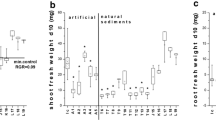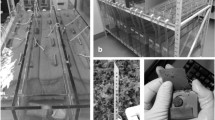Abstract
Purpose
Standardized sediment toxicity assays often employ periodic additions of uncontaminated food to sustain energy and growth requirements of the test organisms. Consequently, selective feeding on this uncontaminated food may reduce exposure to sediment particles containing the test substance. To address this issue, some standard guidelines propose to add food to the sediment before spiking with the test substance to account for multiple exposure routes, including ingestion of contaminated food. The present study focused on the influence of different feeding regimens and compositions of the aqueous medium on water quality (ammonia concentrations) and test organism development.
Materials and methods
Lumbriculus variegatus, Hyalella azteca, and Chironomus riparius larvae were used as test organisms. Ammonia production was investigated under different feeding regimens and test conditions as well as under the presence of a potential inhibitor of nitrification, 4,4'-methylenedianiline.
Results and discussion
Ammonia concentrations strongly depended on the feeding regimen and on the type of food. An influence of 4,4'-methylenedianiline on test organisms or ammonia concentrations was not found at the tested level. Independently of ammonia concentrations, L. variegatus were more sensitive to food type and less sensitive to medium composition than H. azteca. Ammonia levels, emergence ratio, and development rate of C. riparius were not different under periodic feeding and single addition of Urtica. Findings suggest that in case of a “sediment-incorporated” feeding regimen, the time point of food addition to the sediment and careful pH control appear critical. For H. azteca and L. variegatus, an Urtica/cellulose mixture provides a balance between ammonia production and organism development.
Conclusions
This article gives recommendations and caveats for conducting spiked-sediment tests with a single addition of sediment-incorporated food. The presented work also contributed to the development of two recently adopted OECD test guidelines related to sediment toxicity and bioaccumulation testing with endobenthic oligochaetes.

Similar content being viewed by others
References
Åkerblom N, Goedkoop W (2003) Stable isotopes and fatty acids reveal that Chironomus riparius feeds selectively on added food in standardized toxicity tests. Environ Toxicol Chem 22:1473–1480
Ankley GT, Benoit DA, Balough JC, Reynoldson TB, Day KE, Hoke RA (1994) Evaluation of potential confounding factors in sediment toxicity tests with three freshwater benthic invertebrates. Environ Toxicol Chem 13:627–635
Ankley GT, Schubauer-Berigan MK, Monson PD (1995) Influence of pH and hardness on the toxicity of ammonia to the amphipod Hyalella azteca. Can J Fish Aquat Sci 52:2078–2083
Armitage P, Cranston PS, Pinder LCV (1995) The Chironomidae. Chapman & Hall, London
Arrate JA, Rodriguez P, Martinez Madrid M (2004) Tubifex tubifex chronic toxicity test using artificial sediment: methodological issues. Limnetica 23:25–36
ASTM International (2002) Standard test method for measuring the toxicity of sediment-associated contaminants with freshwater invertebrates, E1706-00. In ASTM International 2004 Annual book of standards. Volume 11.05. Biological effects and environmental fate; biotechnology; pesticides. ASTM International, West Conshohocken, PA, USA
Besser JM, Ingersoll CG, Leonard E, Mount DR (1998) Effect of zeolite on toxicity of ammonia to freshwater invertebrates and implications for sediment toxicity identification evaluation (TIE) procedures. Environ Toxicol Chem 17:2310–2317
Borgmann U (1994) Chronic toxicity of ammonia to the amphipod Hyalella azteca: importance of ammonium ion and water hardness. Environ Pollut 86:329–335
Brust K, Licht O, Hultsch V, Jungmann D, Nagel R (2001) Effects of Terbutryn on Aufwuchs and Lumbriculus variegatus in Artificial Indoor Streams. Environ Toxicol Chem 20:2000–2007
De Haas EM, Wagner C, Koelmans AA, Kraak MHS, Admiraal W (2006) Habitat selection by chironomid larvae: fast growth requires fast food. J Animal Ecology 75:148–155
EC (2003) Technical Guidance Document on Risk Assessment in support of Commission Directive 93/67/EEC on Risk Assessment for new notified substances, Commission Regulation (EC) No 1488/94 on Risk Assessment for existing substances and Directive 98/8/EC of the European Parliament and of the Council concerning the placing of biocidal products on the market; Part I – IV. Office for Official Publications of the EC (European Commission), Luxembourg
ECHA (2008) Guidance on information requirements and chemical safety assessment. Chapter R.7b: Endpoint specific guidance. European Chemicals Agency, Helsinki, Finland
Egeler P, Meller M, Schallnaß, HJ, Gilberg D (2005) Validation of a sediment toxicity test with the endobenthic aquatic oligochaete Lumbriculus variegatus by an international ring test. In co-operation with R. Nagel and B. Karaoglan. Technical Report, R&D No.: 202 67 429. Federal Environmental Agency (Umweltbundesamt), Berlin, Germany
Emerson KR, Russo RC, Lund RE, Thurston RV (1975) Aqueous ammonia equilibrium calculations: effect of pH and temperature. Journal of Fisheries Research Board of Canada 32:2379-2383. Referenced after: USEPA (1985) Ambient Water Quality Criteria for Ammonia–1984. EPA 440/5-85-001. U.S. Environmental Protection Agency, Washington, DC, USA
Environment Canada (1997) Biological test method: Test for survival and growth in sediment using larvae of freshwater midges (Chironomus tentans or Chironomus riparius). Report EPA 1/RM/32. Environment Canada. Ottawa, Ontario, Canada
European Chemicals Bureau (2004) Risk Assessment Report Vol.50, 2004, on: Aniline, CAS-No.: 62-53-3, EINECS-No.: 200-539-3. Publication: EUR 21092 EN. http://ecb.jrc.it/documents/Existing-Chemicals/Risk_Assessment/Report
Gildemeister T, Leppchen K, Nagel R (2003) Sediment-water Chironomid toxicity test using spiked sediment with internal food source—a more realistic test? Poster presentation at the 13th SETAC Europe Annual Meeting, Hamburg, Germany, April 27–May 01, 2003
Harkey GA, Landrum PF, Klaine SJ (1994) Preliminary studies on the effect of feeding during whole sediment bioassays using Chironomus riparius larvae. Chemosphere 28:597–606
Hochberg Y, Tamhane AC (1987) Multiple Comparison Procedures. John Wiley & Sons, New York
Kemble NE, Dwyer FJ, Ingersoll CG, Dawson TD, Norberg-King TJ (1999) Tolerance of freshwater test organisms to formulated sediments for use as control materials in whole-sediment toxicity tests. Environ Toxicol Chem 18:222–230
Leppänen MT, Kukkonen JVK (1998) Relationship between reproduction, sediment type and feeding of Lumbriculus variegatus (Müller): implications for sediment toxicity testing. Environ Toxicol Chem 17:2196–2202
Liebig M, Meller M, Egeler P (2004) Sedimenttoxizitätstests mit aquatischen Oligochaeten–Einfluss verschiedener Futterquellen im künstlichen Sediment auf Reproduktion und Biomasse von Lumbriculus variegatus. Proceedings 5/2004: Statusseminar Sedimentkontakttests. March 24–25, 2004. BfG (Bundesanstalt für Gewässerkunde), Koblenz, Germany, pp 107–119
Loonen H, Muir DCG, Parson JR, Govers HAJ (1997) Bioaccumulation of polychlorinated dibenzo-p-dioxins in sediment by oligochaetes: influence of exposure pathway and contact time. Environ Toxicol Chem 16:1518–1525
Monda DP, Galat DL, Finger SE, Kaiser MS (1995) Acute toxicity of ammonia (NH3-N) in sewage effluent fo Chironomus riparius: II. Using a generalized linear model. Arch Environ Contam Toxicol 28:385–390
Morgan E (1991) Chemometrics: experimental design. Analytical chemistry by open learning. John Wiley & Sons, New York
OECD (1992) Guideline for Testing of Chemicals No. 203 ‘Fish, Acute Toxicity Test’, Organisation for Economic Co-Operation and Development, Paris, France
OECD (2004) OECD Guideline for the Testing of Chemicals No. 218: ‘Sediment-water chironomid toxicity test using spiked sediment’ (adopted April 2004). Organisation for Economic Co-Operation and Development, Paris, France
OECD (2007) OECD Guideline for the Testing of Chemicals No. 225: Sediment-Water Lumbriculus Toxicity Test Using Spiked Sediment (adopted October 2007). Organisation for Economic Co-Operation and Development, Paris, France
OECD (2008) OECD Guideline for the Testing of Chemicals No. 315: Bioaccumulation in Sediment-dwelling Benthic Oligochaetes (adopted October 2008). Organisation for Economic Co-Operation and Development, Paris, France
Pery A, Mons R, Flammarion P, Lagadic L, Garric J (2002) A modeling approach to link food availability, growth, emergence, and reproduction for the midge Chironomus riparius. Environ Toxicol Chem 21:2507–2513
Ribeiro R, Kelly LA, Gonçalves FJM, Burton GA, Soares AMVM (1999) New artificial sediment for Chironomus riparius toxicity testing. Bull Environ Contam Toxicol 63:691–697
Riedhammer C, Schwarz-Schulz B (2001) The newly proprosed EU risk assessment concept for the sediment compartment. J Soils Sediments 1(2):105–110
Ristola T (1995) Effects of feeding regime on the results of sediment bioassays and toxicity tests with chironomids. Ann Zool Fenn 32:257–264
Schubauer-Berigan MK, Monson PD, West CW, Ankley GT (1995) Influence of pH on the toxicity of ammonia to Chironomus tentans and Lumbriculus variegatus. Environ Toxicol Chem 14:713–717
Schupp T, West RJ (2007) Primary aromatic amines: the contribution of sediment organisms to human exposure. EXCLI Journal 6:187–196
Skinner HCW, Jahren AH (2003) Biomineralization. In: Schlesinger WH (ed) Biogeochemistry, vol 8, Treatise on Geochemistry. Elsevier-Pergamon, Oxford, pp 117–184
Stuijfzand SC, Poort L, Greve GD, van der Geest HG, Kraak MHS (2000) Variables determining the impact of diazinon on aquatic insects: taxon, developmental stage, and exposure time. Environ Toxicol Chem 19:582–587
US EPA (2000) Methods for measuring the toxicity and bioaccumulation of sediment-associated contaminants with freshwater invertebrates, Secondth edn. EPA 600/R-99/064, U.S. Environmental Protection Agency, Duluth, MN, USA
West RJ, Henry KS, Davis JW (2004) Preliminary study to determine an appropriate equilibration period and feeding mode for evaluating chronic toxicity of toluenediamines (TDA) to sediment dwelling organisms according to OECD proposed test guideline 218. International Isocyanate Institute report no. 234-EU-ENV. The Scientific Office, Global Isocyanates Ltd., Bridgewater House, Whitworth Street, M1 6LT Manchester, UK
Whiteman FW, Ankley GT, Dahl MD, Rau DM, Balcer MD (1996) Evaluation of interstitial water as a route of exposure to ammonia in sediment tests with macroinvertebrates. Environ Toxicol Chem 15:794–801
Acknowledgments
The authors wish to thank the following persons: Thomas Schupp (Elastogran GmbH, BASF Polyurethane, Lemfoerde, Germany), Andreas Seidel (Bayer Industry Material Science, Leverkusen, Germany), and Bob West (The Dow Chemical Company, Midland, MI, USA) for useful advice on study design and comments on the manuscript; Norbert Caspers (Bayer Industry Services, Leverkusen, Germany) for comments on earlier versions of the manuscript; Marika Goth, Kerstin Kronenberger and Daniel Gilberg (ECT Oekotoxikologie GmbH) for assistance during test performance; Hans-Joachim Schallnaß (ECT Oekotoxikologie GmbH) for statistical advice; and three anonymous reviewers for helpful comments on the manuscript. These studies were supported by the International Isocyanate Institute, Inc. The conclusions are those of the authors and not necessarily those of the Institute.
Author information
Authors and Affiliations
Corresponding author
Additional information
Responsible editor: Kerstin Hund-Rinke
Rights and permissions
About this article
Cite this article
Egeler, P., Henry, K.S. & Riedhammer, C. Potential effects of food addition to sediment on test conditions in sediment toxicity tests. J Soils Sediments 10, 377–388 (2010). https://doi.org/10.1007/s11368-009-0169-7
Received:
Accepted:
Published:
Issue Date:
DOI: https://doi.org/10.1007/s11368-009-0169-7




